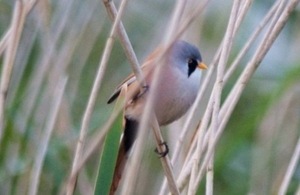Record breeding season for rare wetland birds in Somerset
The bearded tit, one of the UK’s rarest and fussiest birds is on the increase at a Somerset nature reserve.

Bearded tit © Rob Balch
Thanks to the hard work of volunteers at Shapwick Heath National Nature Reserve (NNR), a total of more than 170 bearded tits or ‘bearded reedlings’ were recorded over a 4 week period at the reserve this autumn. Over 70 birds were recorded on one day alone.
The first ever survey of the birds at Natural England’s Shapwick Heath NNR has revealed the encouraging results. It proved that there are more of the rare birds using the reedbeds at the reserve than previously known.
As recently as 10 years ago the total number of bearded reedlings in the whole of Somerset was probably only around 20 birds. The birds are very particular about where they live. They are only found in reedbeds, where they nest among the reed stems and feed on reed seeds and reedbed insects. With only around 600 breeding pairs in the UK, they are one of the country’s rarest birds and a target for special conservation effort. Shapwick Heath is one of only a handful of places in the south west where the sparrow-sized birds are found and may have been attracted by the mosaic of rich wetland habitat that has been created.
Robert Balch is one of the volunteers who organised the survey. He said:
I’ve been volunteering for Natural England at Shapwick for several years and when you’re here regularly you get to know a place and its wildlife. Some of us felt that the numbers of bearded reedlings at Shapwick had increased in recent years and so we came up with the idea of having a proper survey to gather the evidence. It’s involved some early starts and a soaking in the rain, but we’ve proved there is a healthy population here. It’s great news that these delightful birds are bouncing back at Shapwick and it must be a sign that the reedbeds on the NNR are being managed well.
The group planned the survey with the help of Natural England reserve manager, Simon Clarke, and it was carried out over a 4 week period between mid-September and early-October at 5 specific areas within the 500 ha reserve.
Natural England’s NNR manager, Simon Clarke, said:
We are incredibly privileged to have such a supportive and dedicated team of volunteers who were willing to go out in all weathers to help gather important, new evidence about the numbers of these rare birds. The results are great news for the Shapwick Heath NNR and we hope that the birds will spread from their stronghold here in the Avalon Marshes and colonise other sites in the south west.
The reedbeds at the Avalon Marshes are now establishing very successfully and are providing the ideal habitat for a variety of wetland-loving wildlife, including bearded reedlings and bitterns. The results of this first-ever survey of the birds at Shapwick Heath are very encouraging indeed and we’ll be repeating it in future years to monitor any changes.
Early mornings are the best time to count bearded reedlings. In the autumn, the birds erupt from the reedbeds in the early morning to gather and fly high above the reeds, perhaps dropping into a new part of the same reedbed, or occasionally leaving the site altogether and flying off to new locations.
Natural England would like to thank all the volunteers who took part in the survey: Kevin Anderson, Alan Ashman, Robert Balch, Dick Best, Mike Hannon, Peter Kelly, Andrew Kirby, Paul Morrissey, Suzie Robson, Martin Sage, Shelly Saltman, Bill Urwin and Dionn Warner.
Background
About bearded reedlings (Panurus biarmicus)
- usually known as bearded tits - because of a superficial resemblance to long-tailed tits - these birds are not member of the tit family. Panurus biarmicus may in fact by a unique species and the only member of their family
- they are sparrow-sized with a long tail and weigh just 15g
- generally orange in colour, the males has a blue head and black ‘moustaches’ on its cheeks
- they are only found in reedbeds
- bearded tits pair for life; they lay up to 8 eggs in nests low down in the reeds and can raise 4 broods in a season
- bearded tits are very vulnerable to cold weather and their breeding can be much reduced after severe winters and cool, wet summers
- remarkably, bearded tits completely changing their diet between summer and winter; they eat insects in the summer, but feed only on seeds in the autumn, when they need to ingest grit to help them digest the tough seeds
About Shapwick Heath NNR
This wetland reserve covers over 500 ha at the heart of the Somerset Levels and Moors. Around 64 different species of birds nest at Shapwick, including Cetti’s warbler and bitterns, while dragonflies and over 27 species of butterfly abound in the summer. These include the silver washed fritillary, purple hairstreak and orange-tip, and the large and impressive white admiral. Over 24 different mammals have been seen at Shapwick, including water voles, lesser horseshoe bats and otters. In the 1960s, peat was removed from the area for horticultural use using huge machines, but this stopped in the 1990s. Today, these former peat pits have been transformed into a landscape of open lakes, reedbeds, fens and wet woodland, and have become a hugely important area for nature conservation.
Reedlings are one of the winter wildlife highlights on the Somerset Levels, as they recover from last year’s floods. Over 100,000 waterbirds, bitterns, otters and the famous starling murmurations - with great local food and accommodation - mean there is plenty to draw visitors to enjoy a wildlife spectacle this winter.
Download a copy of the NNR information for visitors leaflet for more information.